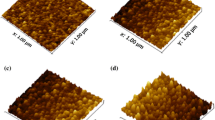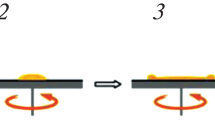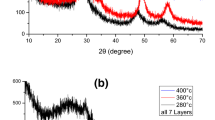Abstract
This paper outlines the preparation of indium-doped zinc oxide films via solvothermal synthesis of nanoparticles, followed by spin coating of the transparent conductive oxide (TCO) layer. The effect of stabilizer type and its concentration on the suspension stability was studied. The influence of the In/Zn molar ratio (in the 0–0.06 range) on the lattice parameters and the cell volume was determined by XRD analysis. A linear change in these parameters was found, indicating a uniform integration of the indium into the ZnO crystal. Thermal analysis using TGA/DTA pointed to the optimal thermal treatment of the TCO layers at 500 °C. In addition, the effect of the molar ratio on the optical and electrical properties was studied. A minimal sheet resistance of <46 ohm/square and optical transparency of >85 % at In/Zn = 0.04 were achieved. The above findings indicate that the solvothermal route can be very effective in the synthesis of state-of-the-art TCO coatings.
Graphical Abstract











Similar content being viewed by others
References
Beyer W, Hüpkes J, Stiebig H (2007) Thin Solid Films 516:147–154
Ehrlich DJ, Tsao JY (eds) (1989) Laser microfabrication: thin film processes and lithography. Academic Press Inc, San Diego
Middleman S, Hochberg AK (1993) Process engineering analysis in semiconductor device fabrication. McGraw-Hill, New York
Ellmer K (2000) J Phys D Appl Phys 33:R17–R32
Kawashima T, Matsui H, Tanabe N (2003) Thin Solid Films 445:241–244
Singh AV, Mehra RM, Buthrath N, Wakahara A, Yoshida A (2001) J Appl Phys 90:5661–5665
Choi CG, Seo S-J, Bae B-S (2008) Electrochem Solid State Lett 11:H7–H9
Lee J-H, Ko K-H, Park B-O (2003) J Cryst Growth 247:119–125
Lee S-Y, Park B-O (2005) Thin Solid Films 484:184–187
Lee J-H, Park B-O (2003) Thin Solid Films 426:94–99
Cimitan S, Albonetti S, Forni L, Peri F, Lazzari D (2009) J Colloid Interface Sci 329:73–80
Brehm JU, Winterer M, Hahn H (2006) J Appl Phys 100:64311 (9pp)
Xing GZ, Yao B, Cong CX, Yang T, Xie YP, Li BH, Shen DZ (2008) J Alloys Compd 457:36–41
Shannon RD (1976) Acta Crystallogr Sect A Found Crystallogr 32:751–767
Feng ZC (2012) Handbook of zinc oxide and related materials: vol. 1, materials. CRC Press, Boca Raton
Shinde SS, Shinde PS, Bhosale CH, Rajpure KY (2008) J Phys D Appl Phys 41:105–109 (6pp)
Tauc J, Grigorovici R, Vancu A (1966) Phys Status Solidi 15:627–637
Srikant V, Clarke DR (1998) J Appl Phys 83:5447–5451
Acknowledgments
The authors acknowledge the generous support of the Nancy and Stephen Grand Technion Energy Program (GTEP), the Leona M. and Harry B. Helmsley Charitable Trust and the Russel Berrie Nanotechnology Institute (RBNI). GES acknowledges the Committee for Planning and Budgeting of the Council for Higher Education under the framework of the KAMEA program. GSG also acknowledges support from the Gruenbaum chair in Materials Engineering.
Author information
Authors and Affiliations
Corresponding author
Rights and permissions
About this article
Cite this article
Dinner, O., Shter, G.E. & Grader, G.S. Solvothermal synthesis of indium-doped zinc oxide TCO films. J Sol-Gel Sci Technol 81, 3–10 (2017). https://doi.org/10.1007/s10971-016-4153-6
Received:
Accepted:
Published:
Issue Date:
DOI: https://doi.org/10.1007/s10971-016-4153-6




